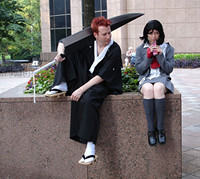 Overall Rating: B
Overall Rating: BSynopsis: Created by Bisco Hatori, this shōjo supernatural romance story follows Chiyuki Matsuoka, a young woman in high school with a weak heart. When she was born, the doctors said she would be lucky to live until she was 15. She now tries to live to see it snow as many times as possible.
One evening, she sees a young man in a black coat jump off a building, and she goes to find him, only to discover that the man is unhurt. She learns that his name is Tōya Kanō, and that he is a vampire. He also has the opposite problem that Chiyuki has, he will live one thousand years. In the world of Millennium Snow, vampires also mate for life with a human whom they feed from. The human also lives one thousand years. When Chiyuki finds this out, she offers her blood to Tōya so she can live longer.
Tōya refuses, claiming that he hates humans and blood. The truth is that he doesn't hate humans and he likes blood, but he doesn't want to burden anyone. However, he gives Chiyuki some of his blood when she has a fatal heart attack, so that she can continue to live.
After she recovers, Chiyuki is able to go back to school for the first time in a year, and tricks (it's not a very good trick, so Tōya must not be very smart), Tōya into joining the school so he will be around people more often. Also, Tōya has a bat companion named Yamimaru who talks strangely (I'm not sure why).
After reading the first four volumes of Ouran High School Host Club and loving it, I was eager to check out Bisco Hatori's first manga, Millennium Snow. It has some similar themes to Ouran, for example that both female protagonists grew up with one or both parents dead, but it's not as well done as Ouran is. Still, I enjoy a good supernatural shōjo, and in the first volume a werewolf is introduced at the high school who is also vying for Chiyuki's affections. Good times. The series is only two volumes currently, with it being on hiatus because of Hatori's work on Ouran.






